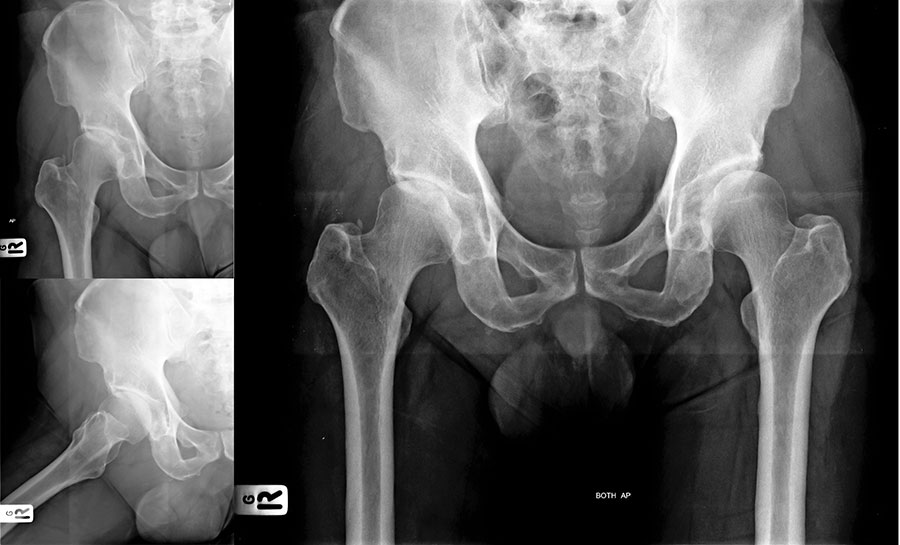Osteitis Pubis is an inflammation of the pelvic symphysis – the cartilage joints between the pubic bones that form the front of the pelvis. The disorder, which can occur when the pelvis is subjected to excessive or repetitive stress, causes pain and may also lead to bone degeneration. The pelvis consist of the hip bones each with 300 elements the sacrum and the coccyx. Osteitis pubis affects a cartridge disc (the pubic symphysis) at the front of the pelvis.
Causes
The condition is commonly associated with sports that involve a lot of running, sudden changes of direction, or weight bearing activity such as hockey tennis and athletics ( Marathon runners are particularly susceptible to osteitis pubis). Anatomical problems such as stiff hip joints or unequal leg length can also be a factor.
What needs to be tested to determine the source of the hip pain
- The movements from your ankle, knee and hip (how they interact with each other)
- Lumbar and Sacral vertebrae
- Pelvis (forwards and backwards tilt)
- Muscles surrounding the hip joint
- Core muscle control and pelvic floor muscles
- All the thigh muscles that attach onto the Femur (Quadriceps,
- Hamstrings, Adductors)
- The Sciatic and Femoral nerves
- The articular surface of the Ball and socket joint of your hips

Diagnosis
Your physiotherapist will be able to diagnose Osteitis Pubis through a thorough physical examination and will search for hip problems, unequal leg length, or other underlying conditions that might be the cause of the inflammation, such as a adductor Strain, or avulsion fractures of the quadricep muscles. X-rays and or an MRI scan may be necessary to assess the severity of the disorder.
Risks and complications
If you spend in sufficient time on rehabilitation, in may suffer from long-term pain as a result. What’s the condition become chronic, recovery time increases significantly and there is a greater risk of recurrence. Untreated, Osteitis pubis may also cause erosion at the edges of your pubic bones
IF YOU THINK YOU MAY HAVE OSTEITIS PUBIS YOU SHOULD:
1. STOP ANY ACTIVITY THAT INCREASES THE PAIN
2. FOLLOW THE PRICE PROCEDURE
3. CALL US TO SET UP AN APPOINTMENT TO CONFIRM THE DIAGNOSIS
Physiotherapists treatment
If you are diagnosed with Osteitis Pubis we may refer you to a Specialist to have an injection around the pubic symphysis. Once other causes are ruled out, your condition is attributed to over use your Physio will advise you to avoid any activities that place stress on your pelvis. If you have bone bruising on either side of the joint you may be given another injection of a specialized drug. Your GP will prescribe pain relief medications.
Osteitis Pubis Pain Treatment
- Acute injury treatment
- Ultrasound
- Medications
- Soft tissue massage
- Electrotherapy treatment
- Laser (Low Level Laser therapy)
- Acupuncture & Dry Needling
- Heat packs (Thermal therapy)
- Kinesiology Tape
- Rigid Strapping or taping
- Neurodynamics (Nerve tissue mobilizations)
- Dynamic Strapping
- Strengthening exercises
- Guided loading protocol
- Stretches (Static, dynamic and ballistic)
- Moon boot
- Brace
- Compression Bandage or Sleeve
- Supportive strapping and taping
- Biomechanical Analysis
- Gait Analysis
- TENS
Early stage
Are physiotherapist use manual therapy and soft tissue therapy to help relieve your symptoms.
We will assess the intensity and duration of your training and correct it is accordingly.
We will perform various physical test of your adductor muscles and your pubic symphysis in order to monitor your recovery.
You may begin:
- Gentle stretches of your quadriceps, adductors, soleus, hamstrings, gastrocnemius and glute muscles. Aim for equals stretches on both sides.
- Isometric adductor squeezes
- Deep water pool running. Aim for 30 minutes at high intensity intervals
Intermediate stage
Your physiotherapist may continue to assess your adductor muscles and your pubic symphysis at each session, you will feel only minimal discomfort.
You may begin:
- Double- and single-leg squats
- Functional warm-up drills, full body exercises, and low-level foot plyometrics
- Upper limb weight exercises ( start at 50% of your one-rep max)
- Adductor pulley exercises
- Core stability exercises
If the injury fails to respond to non surgical treatment (this is rare)
We will recommend surgery to stabilize your pubic symphysis with a plate and screws. This is done by an orthopaedic surgeon. After surgery. Your orthopaedic surgeon may advise you to refrain from sports for up to 6 months. Your doctor will refer you for physiotherapy rehabilitation program to restore the normal movement across the hips and pelvis.

